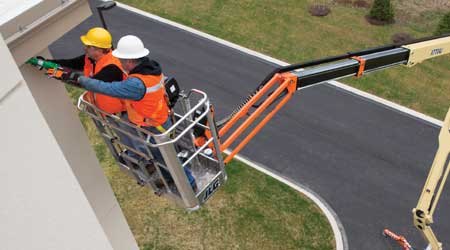Matching Aerial Lifts to Meet Job Requirements
Part 3 of a 3-part article on aerial work platforms
Once managers have an understanding of the the job’s requirements and of workers’ experience with lifts, they can which features, functions and piece of equipment is most appropriate for the job. Among the top considerations for lift equipment are: the maximum reach needed; the maximum weight capacity allowed; and the overall dimensions to ensure access to the job, including lowered height, width, and length.
For example, a project that involves changing high-bay lamps requires elevating technicians, tools and bulbs. Welding requires elevating welders, welding equipment and the material or fabrications to be put into position overhead. These tasks require aerial boom lifts, scissor lifts or telehandlers or some combination of those units.
Depending on the required reach, raising material might require forklifts, telehandlers, boom lifts or mast lifts. Outside work might require units with balloon tires, while inside work on hard, smooth surfaces will require solid-tire lifts.
Controls for working on uneven surfaces need to give the operator the ability to measure the angle of repose and warn of unsafe conditions, or even stop the equipment if tipping danger exists. This situation is the source of many lift-equipment accidents: The load is too heavy for the equipment, the required reach, or the terrain slope conditions, and the result is an imbalance that leads to tipping.
Manufacturers constantly seek feedback on project needs during current construction and repair projects. From this feedback, product developers uncover new trends and incorporate them into designs. For example, manufacturers have developed more compact telehandler models that can handle most jobs. They also have found that only a few jobs require larger pieces of equipment with higher capacities. More compact units match needs of most projects more economically and with improved productivity in tight workspaces. Crews also can tow compact lifts behind a work truck, eliminating trailer transport costs to and from the job site.
In addition to conventional uses, such as moving brick and block pallets, structural steel and pipe, and heavy equipment, managers should consider other uses for lifts that add to jobsite productivity and higher utilization. For example, more departments use of a combination of a towable compact telehandler, a work truck, and a mast-controlled work platform or scaffold. The mast-controlled scaffold can be moved between locations using one telehandler operator and eliminating the need for a crew to disassemble and assemble scaffolding for every move.
When not moving the work platform, crews can use the telehandler to move a range of equipment, including welders, HVAC equipment, auxiliary power plants, and materials such as pipe, duct, bricks, concrete block, wall panels, structural steel, and pallets of materials.
Thomas A. Westerkamp is a maintenance and engineering management consultant and president of the work management division of Westerkamp Group LLC, www.westerkampgroup.com.
Related Topics:












